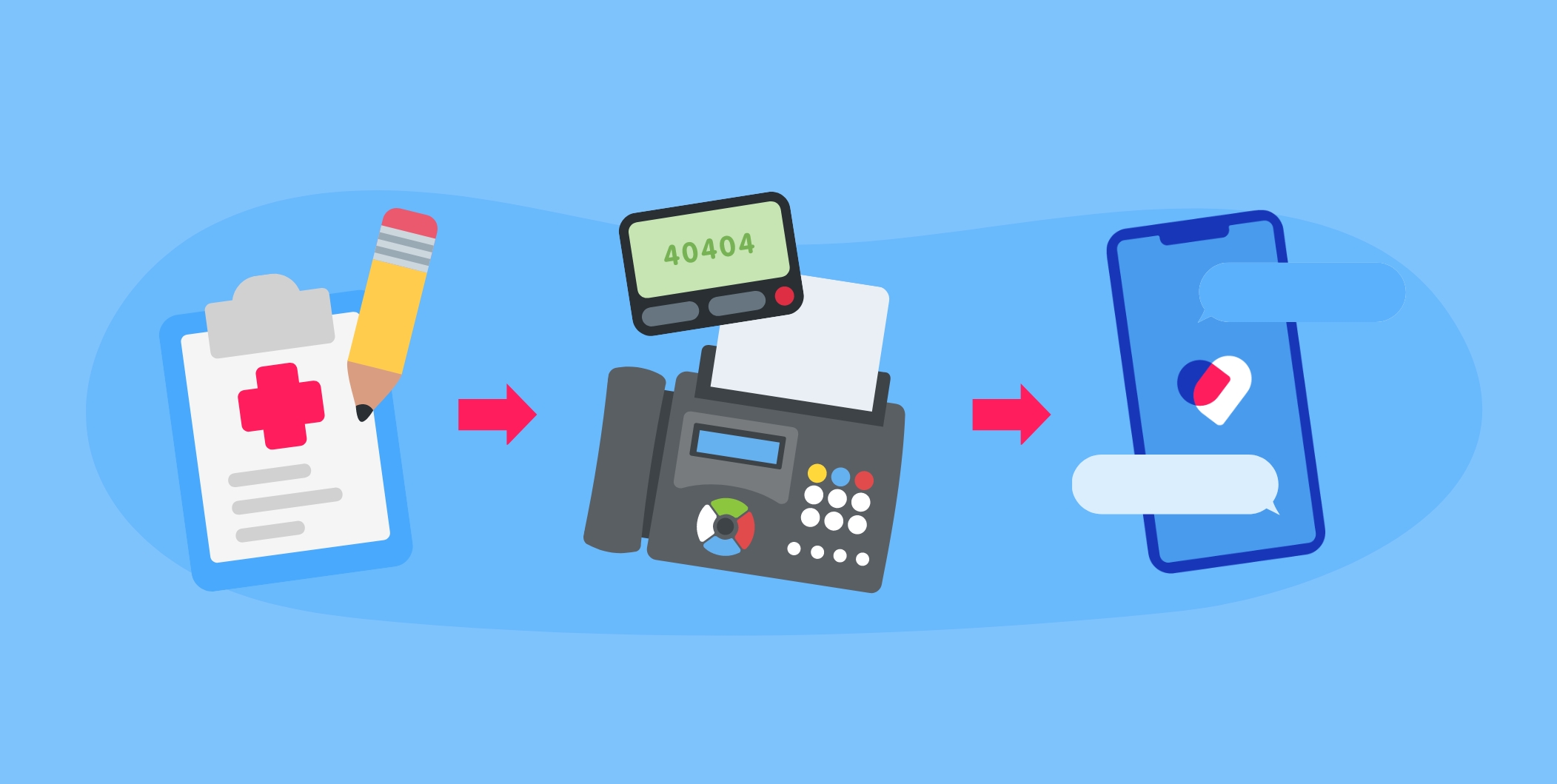Nov 5, 2025
The Evolution of Communication in Healthcare Settings
Mar 07, 2024 - Blog
In this blog, we look at how healthcare communication methods have changed from handwritten notes to modern digital technology.
We’ll explore the major changes, the role of technology, and what this means for patients and healthcare professionals today.
Why is communication important in healthcare?
Effective communication in healthcare is essential for several key reasons. It ensures the accurate exchange of information about a patient’s condition and treatment, which is crucial for making informed decisions and avoiding medical errors.
Good communication improves patient outcomes by ensuring clear understanding and agreement on treatment plans, leading to better adherence and satisfaction. To learn more, check out this article.
Moreover, it enhances patient safety, as clear instructions and feedback can prevent potentially life-threatening mistakes. Clear communication builds a stronger patient-provider relationship, fostering an environment of trust and respect, which is fundamental for a successful healthcare experience.
What were the traditional methods of communication in healthcare?
Historically, healthcare communication primarily relied on paper-based methods, such as handwritten notes, charts, prescriptions, and referral letters, which needed physical storage and manual handling.
In addition to paper records, direct interactions through face-to-face conversations and telephone calls were standard practices. These traditional methods formed the core of patient care management, serving various purposes from recording medical histories to planning treatments and organizing appointments.
What limitations did these early communication methods face?
Traditional communication in healthcare faced several challenges. Paper records could be lost or misfiled, leading to errors in patient care. Illegible handwriting could result in treatment mistakes.
Direct conversations and phone calls lacked permanent records, making tracking patient progress difficult. Additionally, relying on postal services for sharing information between facilities was slow, causing treatment delays.
These problems highlighted the need for improved methods in healthcare.
The introduction of electronic communication
How did telephones and faxes change communication in healthcare?
Telephones and faxes revolutionized healthcare communication by enabling quicker exchanges of information. Telephones facilitated immediate conversations between healthcare providers and patients, speeding up decision-making and responses to emergencies.
Faxes allowed for the fast transfer of patient documents, improving the efficiency of information sharing between facilities.
What were the benefits and limitations of these technologies?
Benefits:
- Speed: Reduced time for communication and decision-making
- Accessibility: Easier patient access to healthcare providers
- Documentation: Quick transmission of documents
Limitations:
- Privacy Risks: Potential breaches in patient confidentiality
- Technical Issues: Communication could be disrupted by equipment or network problems.
- Incomplete Information: Telephone calls lacked a written record, and faxes could lead to lost or incomplete data.
The digital revolution: Email and Electronic Health Records (EHR)
What is an Electronic Health Record (EHR) in healthcare?
An Electronic Health Record (EHR) is a digital version of a patient’s medical history and care documentation, maintained by the healthcare provider over time. EHRs are designed to collect and compile various types of patient information, including diagnoses, medications, treatment plans, allergies, radiology images, and laboratory test results.
Unlike traditional paper records, EHRs enable access to patient information by multiple healthcare professionals across different healthcare settings, facilitating coordinated, efficient, and quality care.
What are the privacy, security, and functionality issues associated with these digital tools?
Privacy, security, and functionality issues significantly impact the use of EHRs. Concerns include data breaches that expose sensitive patient information, privacy worries about who accesses patient histories, and the need to comply with strict regulations like HIPAA, which can be challenging and expensive.
Functionality problems include the usability of EHR systems, which can be inefficient and error-prone, issues with interoperability that prevent seamless information sharing between different healthcare systems, and the extensive training and adaptation required for effective EHR implementation and use.
The rise of telemedicine and mHealth
The rise of telemedicine and mobile health (mHealth) represents a significant shift in the healthcare industry, offering new opportunities for patient care and medical management. These technological advancements enable healthcare professionals to provide services remotely, increasing accessibility for patients, especially those in rural or underserved areas.
Related article: Supporting Healthcare Teams in Remote Areas
mHealth applications allow for constant health monitoring and data collection, empowering patients to take an active role in their own health management.
As these digital tools continue to evolve, they promise to enhance the efficiency of healthcare delivery and improve inpatient outcomes, marking a new era in medical practice and patient engagement.
How do mobile health (mHealth) applications affect patient-provider communication?
mHealth applications are transforming patient-provider communication by making it more accessible, efficient, and continuous. With features such as messaging, video consultations, and remote monitoring, these apps bridge the gap between in-person visits, allowing for real-time health updates and advice.
This immediacy and ease of access improve patient engagement and adherence to treatment plans. Furthermore, mHealth apps facilitate a more collaborative approach to healthcare, enabling patients to actively participate in their health management and decision-making processes.
Related article: Communicating With Patients Via Messaging Apps
How are artificial intelligence (AI) and machine learning improving healthcare communication?
AI and machine learning are revolutionizing healthcare communication by personalizing patient interactions and enhancing information accuracy. AI-powered chatbots and virtual health assistants provide immediate, 24/7 responses to patient injuries, reducing wait times and freeing up healthcare professionals to focus on more complex cases.
Machine learning algorithms analyze vast amounts of data to identify patterns, predict health trends, and provide personalized health recommendations, leading to more informed patient-provider discussions and tailored treatment plans.
What are the ethical considerations of AI in healthcare communication?
The integration of AI in healthcare communication brings several ethical considerations, including privacy, consent, and transparency. Ensuring the security of sensitive patient data and obtaining informed consent for its use are paramount.
Additionally, there’s a need for transparency regarding how AI tools process and interpret patient information to avoid miscommunication and misdiagnosis.
There’s also the challenge of maintaining the human element in healthcare, ensuring that AI supports rather than replaces the empathy and understanding provided by human providers. To learn more about navigating AI in healthcare, check out this article.
How are social media and online platforms being used in healthcare?
Social media and online platforms are reshaping healthcare by improving communication, education, and community engagement. They are valuable tools for healthcare professionals and organizations to spread public health messages, update research findings, and educate a wider audience while facilitating real-time patient-provider interactions.
These platforms support professional networking among healthcare workers and provide a communal space for patients to exchange support and experiences.
However, despite their benefits, the use of these platforms in healthcare raises privacy, misinformation, and digital divide concerns, highlighting the need for ethical standards and digital literacy.
Related article: How To Responsibly Share Medical Photos
Challenges and future directions
Navigating the complex landscape of healthcare systems, interoperability issues, and diverse patient populations poses significant challenges to effective communication within the industry. However, embracing emerging technologies offers promising avenues for enhancing communication, improving patient engagement, and ultimately transforming the delivery of healthcare services in the future.
What are the current challenges in healthcare communication?
In today's healthcare landscape, communication faces critical challenges due to system fragmentation, hindering seamless patient care. Varying levels of health literacy among patients complicate conveying medical information clearly, while privacy concerns surrounding digital data exchange demand robust security measures.
Cultural and linguistic barriers require tailored approaches for effective cross-cultural communication. Furthermore, healthcare professionals’ increasing susceptibility to burnout impacts communication quality amid mounting time and resource pressures.
What future trends and technologies might influence healthcare communications?
In the near future, several emerging trends and technologies are set to transform healthcare communication. Telemedicine and virtual care platforms will improve accessibility and facilitate communication between patients and providers by enabling remote consultations, monitoring, and education.
Furthermore, Celo’s secure messaging solution ensures the secure and transparent exchange of healthcare data, preserving integrity and patient privacy across systems. Embracing such innovations from Celo presents promising opportunities to tackle current communication challenges and elevate healthcare service delivery.
About the Author:

Marketing Associate at Celo
Remy is a passionate and creative marketer at Celo Health, a leading company in the healthcare technology sector. As a Marketing Associate, Remy plays a vital role in developing and implementing marketing strategies that not only highlight Celo Health's cutting-edge solutions but also engage and inform a diverse audience about the importance of secure technology in healthcare.


